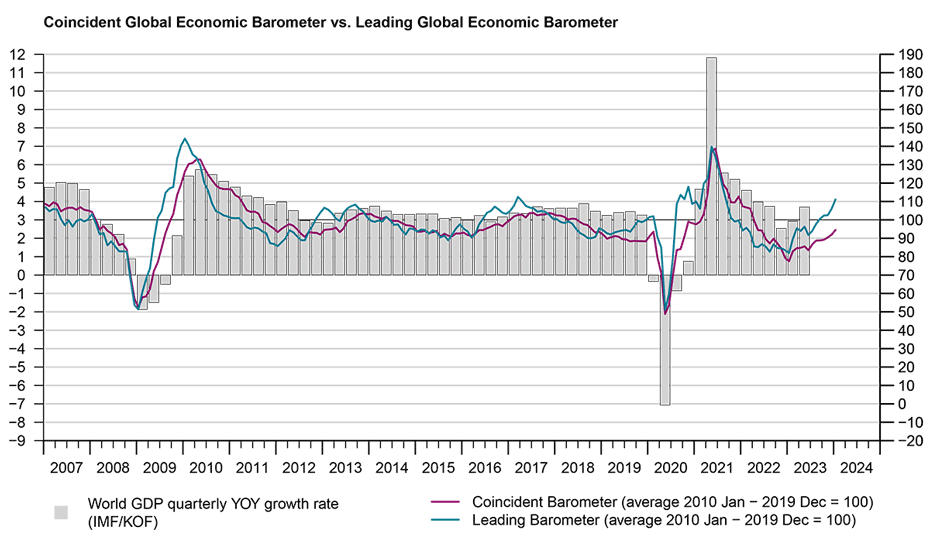Global Barometers on the rise
The Global Barometers continue to increase, signalling an acceleration in world economic growth at the turn of the year. However, despite the seventh consecutive rise, the Coincident Barometer remains below its average of 100 points. The Leading Barometer reaches its highest level since 2021.

The Coincident Global Economic Barometer increases by 2.5 points to 94.5 points in January, remaining below the 100-point mark. The Leading Barometer increases by 5.1 points to 111.1 points, its highest level since August 2021 (116.8 points). In both cases, the Asia, Pacific & Africa region is the main contributor to the increase, while the Western Hemisphere makes a modest positive contribution and the indicators for Europe move in the opposite direction. With the stronger increase in the Leading Barometer for the second consecutive month, the difference between the two indicators is now 16.6 points, the largest since November 2020 (19.0 pts.).
"While the coincident indicator is still below average, the leading indicator really takes off this month, mainly driven by the more optimistic outlook in the Asia-Pacific and Africa regions. In Europe, however, both the outlook and the current situation have deteriorated slightly. So while the global recovery continues, some regions seem to be driving it more than others. Perhaps the greater focus on the war in Ukraine and Gaza in the European media can explain some of this difference" evaluates KOF Director Jan-Egbert Sturm the latest results.

“The leading indicator really takes off this month, mainly driven by the more optimistic outlook in the Asia-Pacific and Africa regions.”Jan-Egbert Sturm, Director of KOF Swiss Economic Institute
Coincident Barometer – regions and sectors
The indicator for the Asia, Pacific & Africa region contributes 2.2 points to the 2.5-point increase in the Coincident Barometer in January, the Western Hemisphere contributes 0.4 points, while Europe is a negative contributor with -0.1 points. The regional coincident indicators point to a relatively resilient global economy, despite the efforts to contain inflation in some countries and some signs of slowdown in the Chinese economy.(the graph below shows the contribution of each region to the deviation of the Coincident Barometer from its historical average of 100 points).
Among the Coincident sector indicators, the Services sector rises strongly, followed by Industry and Economy (aggregated business and consumer assessments). Construction moves in the opposite direction, while Trade (retail and wholesale) remains unchanged this month, breaking a streak of six consecutive increases.
Leading Barometer – regions and sectors
The Leading Global Barometer leads the world economic growth rate cycle by three to six months on average. In January, the regional contributions to the indicator follow a similar path to the Coincident Barometer. The Asia, Pacific & Africa region contributes 5.3 points to the indicator, the Western Hemisphere 0.3 points and Europe -0.5 points. Within this framework, the indicator for the Asia, Pacific & Africa region stands out from the other regions and signals an extremely positive outlook for the growth of activities in the coming period.
In January, all the Leading sector indicators rise, with Construction and Trade standing out. All indicators are at their highest levels since the second half of 2021, reflecting a broadly positive outlook for the months ahead.

The Global Economic Barometers
The Global Economic Barometers are a system of indicators enabling timely analysis of global economic development. They represent a collaboration between the KOF Swiss Economic Institute of the ETH Zurich in Switzerland and Fundação Getulio Vargas (FGV), based in Rio de Janeiro, Brazil. The system consists of two composite indicators, the Coincident Barometer and the Leading Barometer. The Coincident Barometer reflects the current state of economic activity, while the Leading Barometer provides a cyclical signal roughly six months ahead of current economic developments.
The two Barometers comprise the results of economic tendency surveys conducted in more than 50 countries with the aim of achieving the broadest possible global coverage. The advantages of economic tendency surveys are that their results are usually readily available and are not substantially revised after first publication.
The Coincident Barometer includes more than 1,000 different time series, while the Leading Barometer consists of over 600 time series. Cross-correlation analysis is used to decide which individual time series are included in the barometers. This involves correlating the individual time series with a reference series. The reference series used is the year-on-year growth rate of global gross domestic product (GDP), where the individual national GDPs are aggregated at purchasing power parity to form global GDP. A time series is only included in a Barometer if it shows a sufficiently high correlation and a suitable synchronization or lead with the reference series. The time period used for this correlation analysis currently runs from January 2010 to December 2019.
The series of the two Barometers are revised each month at publication and are standardized to have a mean of 100 and a standard deviation of 10 for the 10-year period previous to the most recent observations.
The methodology is described in:
Klaus Abberger, Michael Graff, Aloisio Jr. Campelo, Anna Carolina Lemos Gouveia, Oliver Müller and Jan-Egbert Sturm (2020), The Global Economic Barometers: Composite indicators for the world economy. KOF Working Papers, vol. 471, Zurich: KOF Swiss Economic Institute, ETH Zurich, 2020.
Contact
KOF Konjunkturforschungsstelle
Leonhardstrasse 21
8092
Zürich
Switzerland

